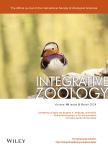Sexual size dimorphism in lizards:Rensch’s rule,reproductive mode,clutch size,and line fitting method effects
作者机构:College of Animal ScienceXinjiang Agricultural UniversityUrumqiXinjiangChina College of ForestryNanjing Forestry UniversityNanjingJiangsuChina School of Zoology&the Steinhardt Museum of Natural HistoryTel Aviv UniversityTel AvivIsrael
出 版 物:《Integrative Zoology》 (整合动物学(英文版))
年 卷 期:2022年第17卷第5期
页 面:787-803页
核心收录:
学科分类:0710[理学-生物学] 07[理学] 0905[农学-畜牧学] 0906[农学-兽医学] 071002[理学-动物学]
基 金:supported by funds provided to L.S.by the National Natural Science Foundation of China(31660613).
主 题:fecundity selection reduced major axis regression sexual selection sexual size dimorphism viviparity
摘 要:Rensch’s rule relates to a pattern whereby sexual size dimorphism is more female-biased in small-sized species and more male-biased in large-sized ones.We collected literature and museum data on the body size of males and females belonging to 4032 lizard species,as well as data on their reproductive modes and clutch sizes.We used phylogenetic comparative analyses,and general linear mixed models,to test Rensch’s rule and examined how re-productive mode and clutch size affect sexual size dimorphism.Sexual size dimorphism was independent of clutch size in lizard species with variable clutch sizes and in oviparous lizards.Large litters were associated with female-biased sexual dimorphism in viviparous and in scincomorph lizards.Inference regarding Rensch’s rule depended on the analytical method used to identify it.The widely used,but less conservative,reduced major axis regression usually support Rensch’s rule while ordinary least squares regressions mostly show isometric relationships.The rule tended to apply more to oviparous than to viviparous lizards.We infer that Rensch’s rule is,at best,a weak pattern in lizards.This is especially true in viviparous lineages where females reproduce infrequently and therefore evolve large sizes to maximise fecundity,resulting in female-biased dimorphism.



